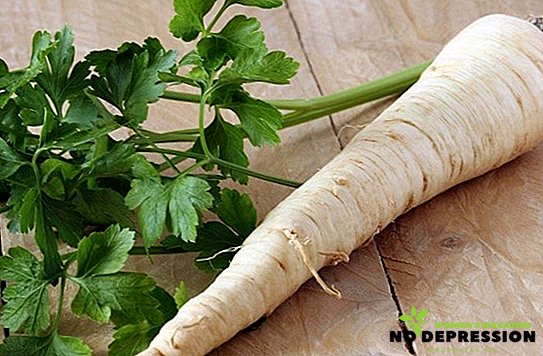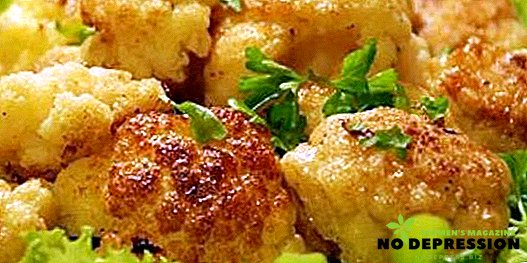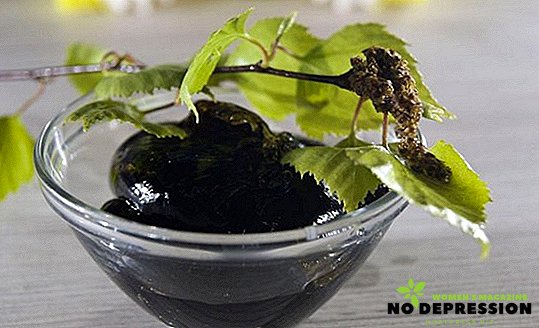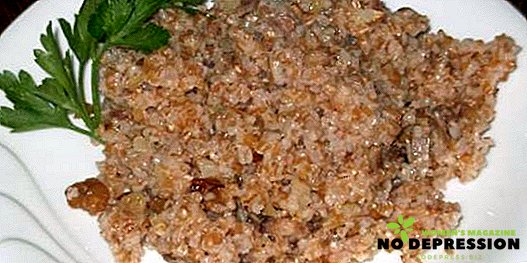Parsley is a aromatic and medicinal plant, which is used to prepare various healing tools and dishes. Usually, greens and seeds are used for therapeutic purposes, but the root of the plant is no less valuable. It has a strong aroma, and is due to the presence of essential oils in it.

Composition and use
Parsley root is part of a plant that, in form and taste, resembles white carrots. It contains carotene in large quantities, and the concentration of ascorbic acid in the root is much higher than in lemon.
The rich and valuable composition of the root gives it a mass of healing properties.
 Parsley root crop is rich in:
Parsley root crop is rich in:
- essential oils;
- organic acids;
- vitamins of various groups;
- starch;
- flavonoids;
- saturated and unsaturated fatty acids;
- coarse fibers.
The composition of the plant root includes minerals such as magnesium, calcium, selenium, manganese and phosphorus. The presence in the root of flavonoids gives it an antioxidant effect, which is especially important in the treatment of various types of pathologies.
Medicinal properties of parsley roots
The beneficial properties of the root of the plant were noticed long ago by both doctors and traditional healers.
Proper use of products based on this plant allows you to achieve the following results:
- metabolic processes are normalized, which has a positive effect on weight and blood composition;
- improves the functioning of the digestive system;
- the concentration of glucose and cholesterol in the body is restored;
- improves the patient's condition with measles and scarlet fever;
- the unpleasant symptoms of prostatitis disappear and the recovery of the patient is accelerated;
- harmful substances, toxins and heavy salts are removed from the body;
- normal functioning of the kidneys and organs of the excretory system.

Parsley root is considered an effective means to whiten the skin of the face and eliminate the inflammatory process. In addition, it helps to accelerate the disposal of various diseases of fungal origin and depriving.
Parsley has a mild diuretic effect and can be used as a prophylactic agent in reducing vision and pathologies of the heart and vascular system.
The use of parsley roots in traditional medicine
In case of non-traditional therapy, the root of a plant is used for the preparation of various medicinal products, both dried and fresh. In addition, the root can be eaten and make juice from it.
Infusion to the stomach
Parsley-based products help to normalize the acidity of the gastric juice, with their constant intake, it is possible to restore the functioning of the digestive system.
To prepare the infusion for the stomach, you can use the following recipe:
- peel the root, cut it into small pieces and pour 300 ml of water on the mixture;
- cover the resulting mixture with a lid and leave for half an hour to infuse;
- Strain the prepared preparation through a sieve and drink 70-80 ml several times a day before meals several times a day.
Proper reception of such funds from the root of the plant can improve the digestive process, stimulates the production of enzymes in the body and facilitates the absorption of nutrients.
Parsley juice for the heart
 At the root of the plant there is a lot of selenium, which has a positive effect on the functioning of the heart and vascular system. Experts recommend to use root juice for the treatment of defects of the cardiovascular system, and for their prevention.
At the root of the plant there is a lot of selenium, which has a positive effect on the functioning of the heart and vascular system. Experts recommend to use root juice for the treatment of defects of the cardiovascular system, and for their prevention.
To prepare the medicinal product you need:
- wash, peel and carefully chop 200 grams of root and 100 grams of parsley leaves;
- Put the ingredients in a gauze cloth and squeeze the juice out of them.
Before use, dilute 15 ml of juice in half a glass of water and drink a few minutes before meals. It should be remembered that during the day this drug is allowed to take no more than 4 times. It is best to cook the parsley juice mechanically, which will help to preserve more useful properties. Proper use of a folk remedy helps to reduce the patient's pressure, normalize the work of the heart and clean the blood vessels.
Infusion for menstrual disorders
Funds from the plant root help to restore the menstrual cycle and stop bleeding from the uterus. With the correct systematic intake of the infusion based on the root, it is possible to cope with sharp mood changes and relieve pain during menstruation.
To prepare the infusion for menstruation failures in women, you need 2 tablespoons of dry plant roots, pour 0.5 liters of boiling water and cover the dishes with a lid. Infuse the resulting mixture for 20 minutes, then filter and drink 100 ml several times during the day. With the help of such herbal remedies, it is possible to restore the level of hormones in the female body, cope with discomfort during menstruation and normalize the cycle.
To prepare the decoction to restore the menstrual cycle, you must use washed and chopped parsley root. It should be 2 tablespoons of chopped root vegetables, pour 400 ml of hot water and simmer on low heat for no more than 10 minutes. After the broth must be removed from heat, leave for half an hour and filtered. It is recommended to drink such vegetable remedy for 1/2 cup in the morning and evening, starting 7 days before the menstruation.
Broth with edema
 Most often, edema is a sign of impaired kidney function, abnormalities of the heart and vascular system, and an allergic reaction. It is possible to cope with this pathological condition with the help of parsley root, on the basis of which one can prepare infusions and decoctions.
Most often, edema is a sign of impaired kidney function, abnormalities of the heart and vascular system, and an allergic reaction. It is possible to cope with this pathological condition with the help of parsley root, on the basis of which one can prepare infusions and decoctions.
It is possible to eliminate the swelling of tissues with the help of the following infusion:
- wash the roots of plants and twigs and pass them through a meat grinder;
- a glass of this mass pour 400 ml boiling water and leave for 11-12 hours;
- After a while, strain the product and pour freshly squeezed lemon juice into it.
On the day it is necessary to take 1/3 cup 2 times a day. Two days after the start of therapy, it is recommended to take a three-day break and, if necessary, repeat the course.
To prepare the broth to eliminate edema, you need to wash and clean 50 grams of parsley roots, then chop them well. The mass needs to be poured 500 ml of hot water and put to simmer on low heat. Means to cook for 7-10 minutes, then cool to room temperature. This decoction of parsley root is recommended to be taken several times a day, 10 ml for half an hour before meals.
Folk healers claim that by drinking such a drink, one can quickly cope with the swelling of tissues and cleanse the body of waste products. In addition, the tool removes salts from the body, which cause large amounts of fluid to accumulate.
The use of parsley roots in cooking
Parsley root is a common condiment that is added to various dishes. White root is best added to meat, soups, fish and various side dishes. Often this seasoning is used to flavor soups and broths, as well as added to salads and stews. In addition, the plant root can be eaten raw, baked, stewed, boiled and fried.
Root crop perfectly with seafood, poultry, cereals, mushrooms and cheese. Its flavor is a good addition to potatoes, apples, smoked fish, pork and lobsters. When cooking, parsley root can substitute for vegetables such as turnips, carrots and parsnips.
Winter Harvesting and Storage
 When choosing the root parsley, you must remember that the most delicious are the roots of pale beige color, on which there are no spots and other defects. Greens are best used for several days, and the roots can be stored in a cold place for no more than two weeks.
When choosing the root parsley, you must remember that the most delicious are the roots of pale beige color, on which there are no spots and other defects. Greens are best used for several days, and the roots can be stored in a cold place for no more than two weeks.
The difference from the usual root parsley is the presence of fleshy juicy root, which reaches its maximum weight by the end of the year of growth. The best time for harvesting roots for the winter is considered to be autumn in the first year of crop growth or the entire warm period of the second year of growth.
To dry parsley root is necessary at a temperature not exceeding 40 degrees. For this purpose, you can use ovens or special dryers for vegetables.
The best place to store fresh parsley root in the winter is the cellar. In a city apartment, this spice can be stored anywhere.
Contraindications and possible harm
It is not allowed to eat the root of a plant during pregnancy, because it increases the tone of the uterus. Contraindications to therapy are pathologies such as cystitis and nephritis. When taking herbal remedies, unwanted irritation of the tissues of the kidneys may occur.
It is not recommended to use parsley root if the patient has an individual intolerance to its components. The development of unpleasant consequences is possible if a person has epilepsy and problems with calcium metabolism.
Parsley root helps in the formation of stones, but before using it, you should always consult with a specialist. It is important to remember that you do not need to abuse the product. When using the root in large quantities, the development of such side effects as nausea, headache and general weakness of the organism is possible.












